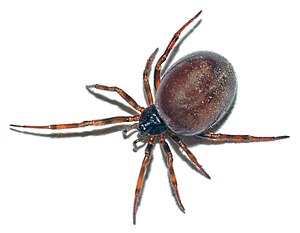Fat spiders
| Fat spiders | ||||||||||||
|---|---|---|---|---|---|---|---|---|---|---|---|---|

Female of the common fat spider ( Steatoda bipunctata ) |
||||||||||||
| Systematics | ||||||||||||
|
||||||||||||
| Scientific name | ||||||||||||
| Steatoda | ||||||||||||
| Sundevall , 1833 |
The fat spiders ( Steatoda ) are a genus comprising more than 120 species from the family of the crested web spiders (Theridiidae). To distinguish them from the genus of spiders, the real widows ( Latrodectus ), they are sometimes referred to as false widows .
Appearance and occurrence
The majority of the spiders are dark, brown, sometimes reddish in color; her body looks greasy and shiny, hence her name. Some species show a deceptive resemblance to the widow spiders ( Latrodectus ), which also belong to the Theridiidae family, due to their spherical appearance and sometimes similarly distinctive colored markings on the abdomen (see picture below, right) . Fat spiders are usually noticeably smaller and do not pose a threat to humans. The largest species ( S. bipunctata , S. hespera ) reach a body length of 8 mm, but in the majority of cases fat spiders are smaller.
Nonetheless, they are able to overwhelm prey that can be significantly larger than themselves - not excluding other spiders - provided they fly, fall or run into the tension ropes of a fat spider. The predominantly nocturnal animals often build their nets, which appear confused or confused at first glance, in buildings, here in sufficiently protected corners, or in the open, mostly near the ground, for example under stones or in crevices.
Systematics

The genus, which is represented worldwide, is very species-rich, with the main area of distribution being in the tropics. So far, the following species have been found in Central Europe:
- Steatoda albomaculata ( De Geer , 1778); in places often in dry and sunny places, up to the mountains (2500 m)
- Common fat spider ( Steatoda bipunctata ) ( Linnaeus , 1758); often, in houses, rocks, mountains up to 2000 m
- Steatoda capensis Hann , 1990; known as the "False Katipo", originally South Africa, introduced to Australia and New Zealand.
- Steatoda castanea ( Clerck , 1757); on buildings and less often on warm forest edges
- Big fat spider ( Steatoda grossa ) ( CL Koch , 1838); Cosmopolitan, in Central Europe only in houses and cellars
- Noble ball spider ( Steatoda nobilis ) ( Thorell , 1875); also known as the "false widow". Originally only found in south-western Europe, it was probably brought in with banana transports from the Canary Islands to England in the second half of the 19th century and is slowly spreading there.
- False black widow ( Steatoda paykulliana ) ( Walckenaer , 1805); also known as the "false widow". In the Mediterranean to Central Asia, prefers dry areas.
- Steatoda triangulosa ( Walckenaer , 1802); rare, absent in northern Europe, in the south only in warm places
Web links
Fat spiders in the World Spider Catalog
- Heimer & Nentwig (1991). Spiders of Central Europe - Online Keys
- Steatoda in the AraGes Wiki
Individual evidence
- ↑ Blick, T., R. Bosmans, J. Buchar, P. Gajdoš, A. Hänggi, P. Van Helsdingen, V. Ružicka, W. Starega & K. Thaler, 2004. Checklist of the spiders of Central Europe. Checklist of the spiders of Central Europe. (Arachnida: Araneae). Version December 1, 2004. ( Memento of the original from August 23, 2016 in the Internet Archive ) Info: The archive link was inserted automatically and has not yet been checked. Please check the original and archive link according to the instructions and then remove this notice.
- ↑ Heimer, Stefan and Nentwig, Wolfgang; 1991: Spinning Central Europe. Publisher Paul Parey Berlin. ISBN 3489535340
- ↑ False widow spider sightings in the UK on the rise. BBC News, October 4, 2013, accessed October 4, 2013 .